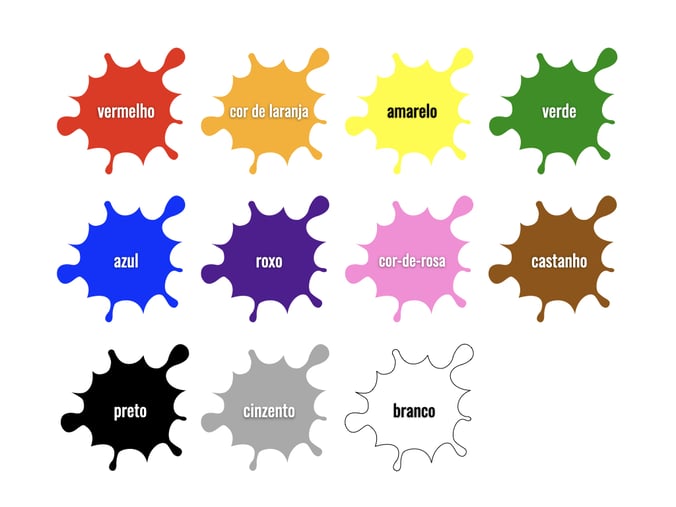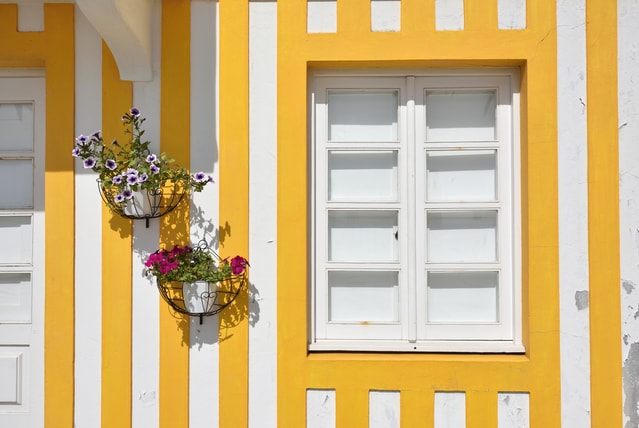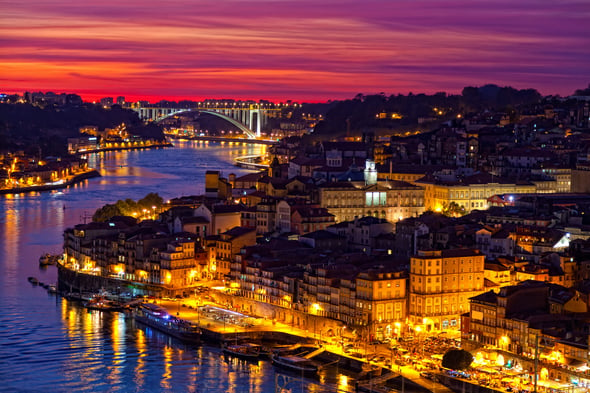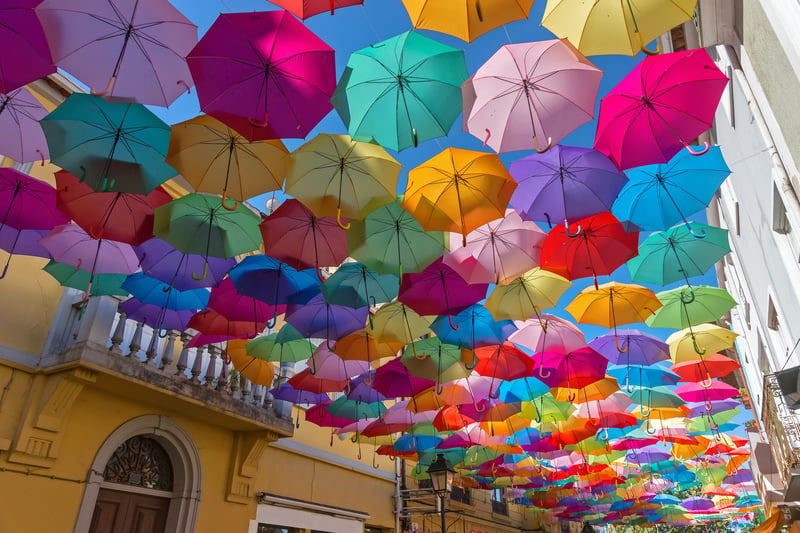Let’s explore some useful vocabulary: colours in Portuguese! Even if you’re not an artist, it helps to know as coresthe colours . How else will you talk about all the beautiful tiles and buildings around you in Portugal? Plus, next time you’re shopping, you’ll have an easier time asking for what you need. You can even use colours to help you describe something when you forget a word.
Colours in Portuguese

- corcolour
- vermelhored
- cor de laranjaorange(colour)
- amareloyellow
- verdegreen
- azulblue
- roxopurple
- cor-de-rosapink
- pretoblack
- castanhobrown
- cinzentogray
- brancowhite
- coloridocolourful
- clarolight
- escurodark
Natural Hair Colour

When talking about natural hair colour, you use different vocabulary:
- loiroblond(masc.) or louroblond(masc.) | loirablond(fem.) or lourablond(fem.)
- morenobrunette, dark-haired or morenabrunette, dark-haired (fem.)
- ruivored-haired(masc.) or ruivared-haired(fem.)
Skin Colour
Preto is the word to describe black objects, but do not use this word to refer to a person with a dark skin colour. Instead, you would say negroblack(masc.) or negrablack(fem.) . Contrary to what you might expect as an English speaker, preto is the term that is considered offensive in Portuguese. Moreno/morena can also describe people with darker skin tones.
Colours as Adjectives vs. Nouns
 Just like other adjectives, colours in Portuguese agree with the noun they describe in number and gender, so you have to change the end of the word accordingly:
Just like other adjectives, colours in Portuguese agree with the noun they describe in number and gender, so you have to change the end of the word accordingly:
- os carros amarelosthe yellow cars
- as casas amarelasthe yellow houses
- Ela é morenaShe is brunette
- pimenta brancawhite pepper
Sometimes, a colour is used as a noun itself. In that case, you use the (default) masculine ending:
- A minha cor favorita é amareloMy favourite colour is yellow
- Vermelho é uma corRed is a colour
- Even though a cor is feminine, yellow and red are nouns in these sentences, not adjectives, so you do not modify them to be feminine.
Exceptions
Verde e Azul
 Some colours in Portuguese do not have a separate feminine and masculine form, like verde and azul, so those do not change based on gender, but they do change based on number.
Some colours in Portuguese do not have a separate feminine and masculine form, like verde and azul, so those do not change based on gender, but they do change based on number.
- o carro verdethe green car
- os carros verdesthe green cars
- a casa verdethe green house
- as casas verdesthe green houses
- o carro azulthe blue car
- os carros azuisthe blue cars
- a casa azulthe blue house
- as casas azuisthe blue houses
Cor de…
 There are a couple other colours in Portuguese that work a bit differently from the rest: cor de laranja and cor-de-rosa. These translate more literally to colour of orange and colour-of-rose.
There are a couple other colours in Portuguese that work a bit differently from the rest: cor de laranja and cor-de-rosa. These translate more literally to colour of orange and colour-of-rose.
Notice that cor de laranja is not hyphenated, but cor-de-rosa is. Portugal’s recent spelling reform (Acordo Ortográfico) did away with lots of hyphens, but cor-de-rosa was an exception.
These colours do not change to match the gender and number, so:
Now that you know the colours in Portuguese, let’s practice them in the following lessons.
Colour Variations
You can probably skip these as a beginner, but just in case you want to get fancy , here are some more obscure colours in Portuguese:
begebeige
amarelo-douradogolden yellow
amarelo-escurodark yellow
verde-clarolight green
azul-bebébaby blue
verde-tropaarmy green
verde-alfacelettuce green
azul-celestesky blue
amarelo-torradoyellow-brown, auburn, 'toasted yellow'
bordôthe colour of red wine, from the French bordeaux



Hello!
If I wanna say a dark-yellow skirt, should I say “uma saia amarelo-escuro” or “amarela-escura”, oooor “amarelo-escura”?
Thanks!
Good question! With compound adjectives formed by two adjectives, it’s the second one that should match the respective noun’s gender and number. So, you should say “saia amarelo-escura”. The first word, “amarelo”, retains the masculine singular that we consider as “default”.
You may already be aware of this, but there are several missing audio clips in this lesson, such as for cor de laranja and cor-de-rosa.
And speaking of these colors, is it common to drop the “cor de” prefix? For example, would one say “uma laranja é laranja” or “uma laranja é cor de laranja”?
Thanks, Peter!
To answer your question, yes, we often drop the “cor de” for these colours, orange and pink. But when we are trying to describe other not-so-standard colours/tones, we’ll probably keep it. E.g. “cor de salmão” (salmon), “cor de ferrugem” (rust), “cor de tijolo” (brick).
In Spanish, in Mexico at least, moreno/a can refer both to hair color and skin color. Is that the case in Portuguese also? If so, is there any risk of offending anyone by referring to people with brown skin tones as morenos?
Same in Portuguese, yes! And the word is generally not considered offensive at all. It’s applicable to people who have natural brown skin tones and also to those who simply got a summer tan. This is discussed in this podcast (starts around minute 8): Os Tons do Português
Really love the fancy colour variations vocab! Thanks for including these. I’m looking forward to using them.
Hi! How do you say Brown in portuguese? Thanks
Castanho, unless you’re talking about hair colour (then see above).
If you’re using it as an adjective, don’t forget to change the ending as needed to match the gender and number of the thing you’re describing: castanho, castanhos, castanha, castanhas.
Muito obrigada
Another unusual color name that I couldn’t figure out for quite awhile is ‘azul de ganga’–denim blue! During the lockdown time, I enjoyed watching Facebook live videos from local women’s clothing shops that were selling direct while their shops were closed. For each item they sold, they would mention a reference number, color, size, and price. Gave me a lot of good listening input!
Just a question, with the word “vermehlo” I hear something like “virmaïlyoo.” I sometimes hear the same words with “ei” or “ehl” with an “aï” sound, and other times as “éï” (sorry, taken from French!). Am I mishearing, or is there a variation depending on the speaker?
Olá! You’re not mishearing – the pronunciation might change from speaker to speaker mostly due to regional accents 🙂 The audio examples in here show how it would sound with a Greater Lisbon accent (which is also pretty much the standard media accent in Portugal).
Olá. How do you say the colour ‘off white’ in Portuguese?
Olá! We have a few different terms for it. ‘Creme’ (cream), ‘branco-sujo’ (“dirty white”) and ‘esbranquiçado’ (whitish) are the ones that come to mind now.
Thank you so much!
Hi, as an Asian, I am still struggling with the pronunciation of “r”. I know for r between vowels, it would pronounce like a “d” as the tongue flips to the upper palate, like in “hora”, sounds like “o-da” (correct me if I were wrong ). But as in the word “amarela”, what I hear from above clips is that the r sound like “L”. Could you please explain more? Muito obrigada.
Good question, this is a tough one! There are some Asian languages that do not differentiate between r and l in the same way that English or Portuguese do, for example. The nature of this difference depends on which Asian language we’re talking about, but unfortunately I don’t have enough knowledge of Asian languages to be able to help much with relating the Portuguese r to the sounds you have in your repertoire.
That said, if you try to use the same sound you use in “hora”, it should sound pretty close. It is basically as you described: a quick tap of the tongue tip on the alveolar ridge (the part of the palate just behind the teeth), the same position as the “d” sound. It’s the same sound in “amarelo”, but it may seem different because the r is followed by a different vowel and the stress in that word is on the syllable containing the r: a-ma-re-lo vs. ho-ra.
It might help to think of making the “tap” while in the process of slightly curling the tongue back. With a lot more listening practice, it should become easier to hear the distinction over time, but it sounds like you’re on the right track already!
It would be great if we could “mark as complete” from translated lessons pages 😉
Hello, I heard some people say Rosa before instead of Cor-de-rosa when talking about something pink, can that also be used or is that just them being lazy?
It’s certainly not uncommon to hear “rosa” used in everyday conversation when referring to the color pink. While “cor-de-rosa” is the full term, “rosa” is often used colloquially and is widely understood. It’s not necessarily laziness; it’s just a more casual way of speaking. Both are correct and perfectly acceptable! 🙂
Red wine is Vinho tinto (ink), right?
And white wine is sometimes Branco and sometimes Verde (for me hard to distinguish those wines), right?
Yes, red wine is vinho tinto and white wine is vinho branco. ‘Vinho Verde’ doesn’t actually describe a wine color, but a wine region, so there are several varieties. In any case, it’s true that most of them are white.
I’m not sure when to use Frutos verdes ou frutos jovens
“Frutos jovens” applies to any unripe fruits. “Frutos verdes” can apply to both unripe fruits or to fruits that are actually supposed to look green all the way. So, it’s all about context.